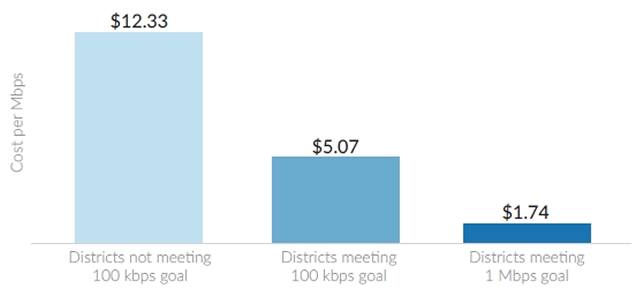Report Examines School Internet Connectivity State by State
- By Dian Schaffhauser
- 12/15/15
An organization that monitors Internet connectivity to schools has reported that while 20 million additional students have been given access to high-speed Internet, a comparably high number "still don't have the speeds they need."
EducationSuperHighway's 2015 "State of the States" report has found that more than three-quarters of school districts (77 percent) meet the widely accepted goal of 100 Kbps per student. That count was only 30 percent in 2013. The remaining 23 percent of districts leave 21 million students lacking the connectivity required for digital learning.
Even when that remaining gap is filled, however, the job won't be done, the report warned, because the target is moving. The connectivity standards established by the Federal Communications Commission (FCC) (originally proposed by the State Education Technology Directors Association) have two levels. The first is Internet access of 100 Mbps per 1,000 users (that 100 Kbps-per-student goal). The second is access of 1 Gbps per 1,000 users or a megabit per second per student, which the "vast majority" of school districts haven't yet put in place, according to EducationSuperHighway.

School districts meeting connectivity goals pay less for Internet access. Figure taken from "2015 State of the States" report by EducationSuperHighway.
Calling states "critical actors" in the job of improving broadband access for their students, the organization intends to monitor state-by-state progress toward achieving connectivity goals and issue annual reports. The analysis is being done on data filed with the FCC's Universal Service Program for Schools and Libraries, otherwise known as E-rate. In 2014, the FCC made all E-rate application data open for the first time, which EducationSuperHighway used as the starting point for its latest work.
Much of the gain made between 2013 and 2015, the researchers found, is due to a decline in the median cost of Internet access, which shrunk from $22 per Mbps in 2013 to $11 per Mbps in 2015. The report noted that for those districts meeting the 100 kbps per student goal, the average cost per megabit is $5.07; within those districts not meeting the goal, the average cost was more than double: $12.33. Similarly, the first group has double the annual budget per student for Internet access compared to the second group: $4.93 vs. $2.08.
To "finish" the job of connecting students in the United States to the Internet appropriately, the organization's researchers offered three broad recommendations for governors:
- First, to provide every school with access to fiber. According to the researchers, 12 percent of schools still lack any access to fiber. As the report noted, state leaders "have a three-year window to take advantage of E-rate funding to build fiber connections to schools that do not currently have it and help school districts obtain the infrastructure they need by providing technical and procurement support."
- Second, to put Wi-Fi into every classroom. That's a major goal of the E-rate modernization program, which is providing $1 billion per year in funding over five years. State leaders can help spend that money wisely by making sure school personnel are educated on "Wi-Fi procurement best practices" and have access to consortia purchasing programs that lower costs.
- Third, to make broadband affordable. This is the number one obstacle, the report said, to schools meeting the FCC's lower tier of connectivity goals let alone keeping up with the expected 50 percent-per-year growth in broadband demand. Governors can take a role, the researchers advised, in promoting consortia purchasing of broadband, protecting price transparency and pushing for state subsidy programs.
The national and individual state reports are available on the EducationSuperHighway site.
About the Author
Dian Schaffhauser is a former senior contributing editor for 1105 Media's education publications THE Journal, Campus Technology and Spaces4Learning.